AUDI S3 SEDAN 2015 Owners Manual
Manufacturer: AUDI, Model Year: 2015, Model line: S3 SEDAN, Model: AUDI S3 SEDAN 2015Pages: 282, PDF Size: 71.14 MB
Page 151 of 282
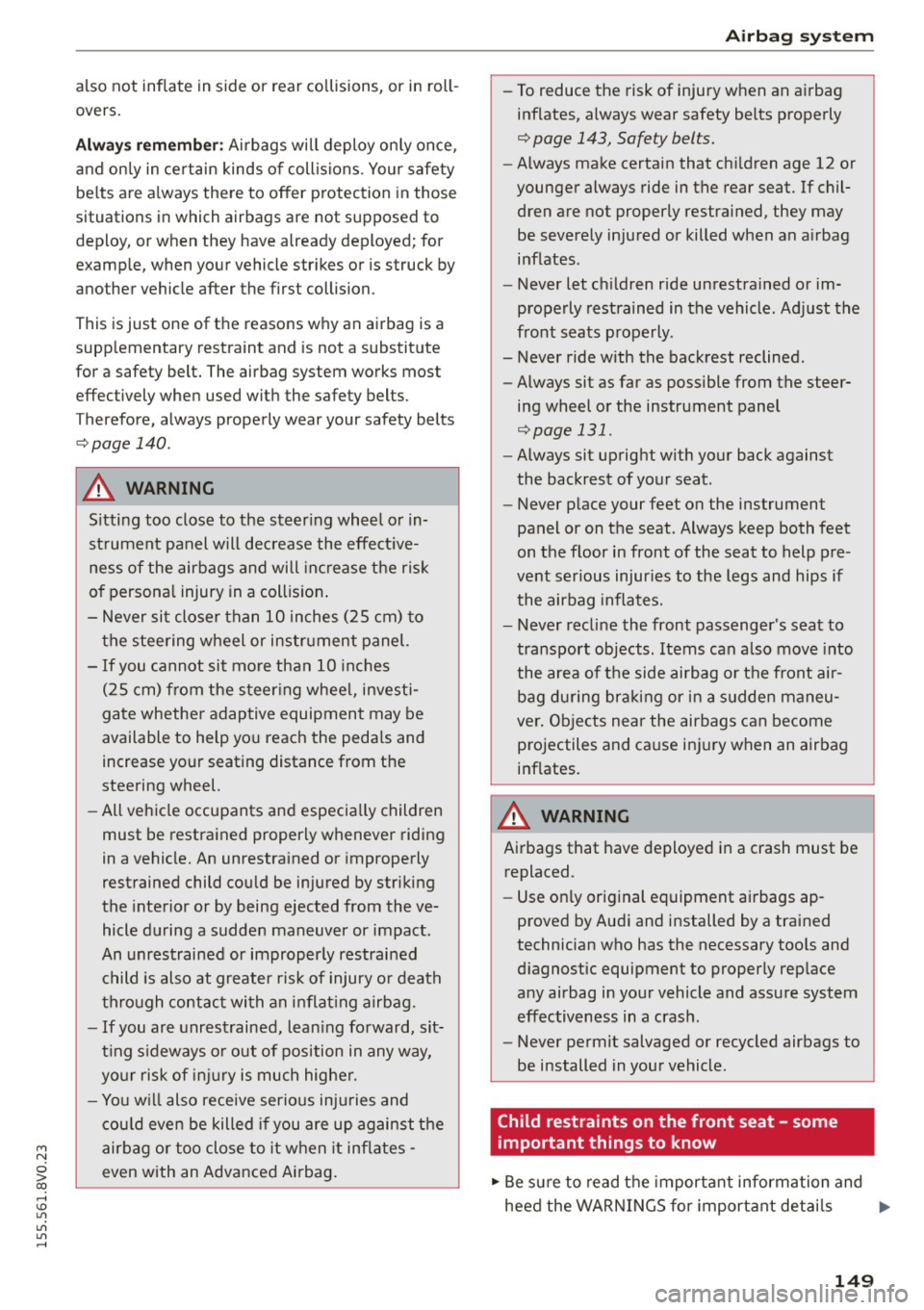
M N
0 > co ,...., \!) 1.1'1
1.1'1
1.1'1
,....,
also not inflate in side or rear co llisions, or in roll
overs .
Alwa ys rememb er: Airbag s wi ll deploy on ly once,
and on ly in cer tain kinds of collisions. Your safety
b e lts a re a lways there to offer protection in those
situations in which airbags are not supposed to
deploy, or when they have already deployed; for
examp le, when your vehicle str ikes or is struck by
another vehicle after the first collision.
This is just one of the reasons why an airbag is a
supp lementary restraint and is not a substitute
for a safety belt. The airbag system works most
effectively when used w ith the safety belts.
Therefore, always properly wear your safety belts
c::>page 140.
A WARNING
Sitting too close to the steer ing whee l o r in
strument panel will decrease the effect ive
ness of the airbags and will increase the risk
o f persona l injury in a coll is ion .
- Never sit closer than 10 inches (25 cm) to
the steering wheel or instrument panel.
- If you cannot sit more than 10 inches
(25 cm) from the steer ing whee l, investi
gate whethe r adaptive equipment may be
available to help yo u reach the peda ls and
increase your seating distance from the
steering wheel.
- All veh icle occupants and especially children
must be restrained properly whenever riding
in a vehicle. An unrestrained or improperly
restrained child cou ld be injured by striking
the inte rior or by being ejected from the ve
hicle during a sudden maneuver or impact.
An unrestrained or improperly restrained
child is also at greater risk of injury o r death
thro ugh contact wi th an infla ting airbag.
- If you are unrestrained, lean ing fo rward, sit
t ing s ideways o r ou t of position in any way,
yo ur risk of in jury is much highe r.
- You w ill also receive serio us inju ries and
c ou ld even be killed if you are up against the
airbag or too close to it when it in flates -
even with an Advanced Ai rbag .
-
Airbag syste m
- To reduce the risk of injury when an a irbag
inflates, always wear safety belts properly
c::> page 143, Safety belts.
- Always make certain that ch ildren age 12 or
younger always ride in the rear seat. If chil
dren a re not properly restrained, they may
be severe ly injured or killed when an a irbag
inflates.
- Never let ch ildren ride unrestrained or im
properly rest rained in the vehicle . Ad just the
front seats p roperly .
- Never ride with the backrest reclined.
- Always sit as far as possible from the steer-
ing wheel or the instrument panel
c::> page 131.
- Always sit upright with your back against
the backrest of your seat .
- Never p lace your feet on the instrument
panel or on the seat. Always keep both feet
on the floor in front of the seat to help pre
vent serious injur ies to the legs and hips if
the airbag inflates.
- Never recli ne the front passenger 's seat to
transport objects. Items can also move into
the area of the side airbag or the front air
b ag during bra king or in a sudden maneu
ver . Ob je cts near the airbags can become
p rojectiles and ca use inj ury when an airbag
inflates.
A WARNING
Airbags that have deployed i n a crash must be
replaced.
- Use on ly original equipment airbags ap
proved by Aud i and installed by a trained
technician who has the necessary too ls and
d iagnostic equipment to properly rep lace
any airbag in your vehicle and assure system
effectiveness in a crash.
- Never permit salvaged or recycled airbags to
be installed in you r vehicle.
Child restraints on the front seat - some
important things to know
.,. Be s ure to read the importa nt information and
heed the WARNI NGS for important detai ls
149
Page 152 of 282
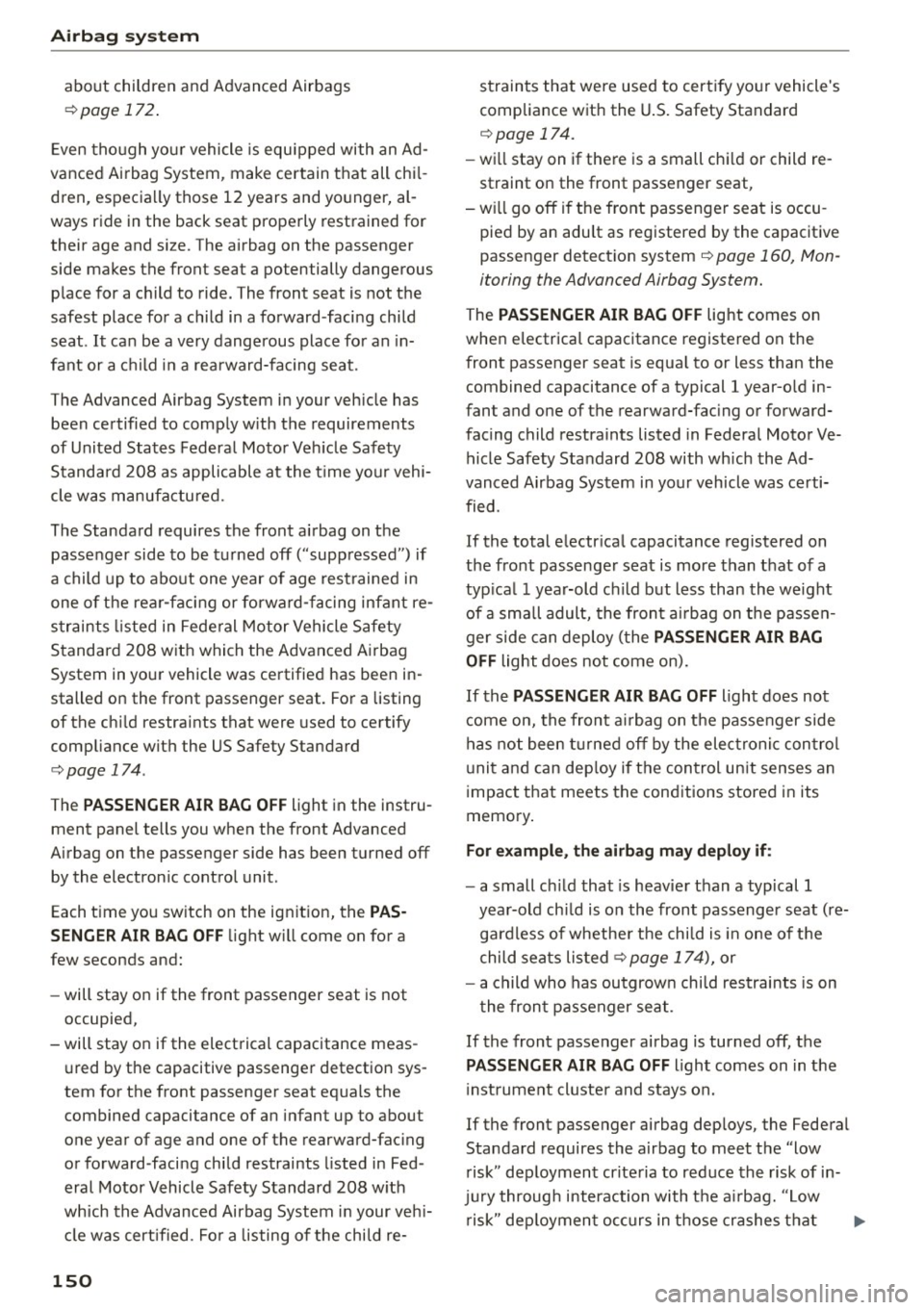
Airbag system
about children and Advanced Airbags
¢page 172.
Even though your vehicle is equipped with an Ad
vanced Airbag System, make certain that all chi l
dren, especially those 12 years and younger, al
ways ride in the back seat properly restrained for
their age and size. The airbag on the passenger
side makes the front seat a potentially dangerous place for a child to ride. The front seat is not the
safest place for a child in a forward-facing child
seat . It can be a very dangerous place for an in
fant or a child in a rearward-facing seat.
The Advanced Airbag System in your veh icle has
been certified to comply w ith the requirements
of United States Federal Motor Veh icle Safety
Standard
208 as applicable at the time your vehi
cle was manufactured.
The Standard requires the front airbag on the
passenger side to be turned off ("suppressed") if
a child up to about one year of age restrained in
one of the rear-facing or forward -facing infant re
s traints listed in Federal Motor Vehicle Safety
Standard 208 with which the Advanced Airbag
System in your vehicle was certified has been in
stalled on the front passenger seat. For a listing
of the ch ild restraints that were used to certify
compliance with the US Safety Standard
¢page 174.
The PASSENGER AIR BAG OFF light in the instru
ment panel tells you when the front Advanced
Airbag on the passenger side has been turned off by the electron ic control unit .
Each time yo u switch on the ignit ion, the
PAS·
SENGER AIR BAG OFF
light will come on for a
few seconds and:
- will stay on if the front passenger seat is not
occupied,
- will stay on if the electrical capacitance meas
ured by the capacitive passenger detection sys
tem for the front passenger seat equals the combined capacitance of an infant up to about
one year of age and one of the rearward-facing
or forward-facing child restraints listed in Fed
eral Motor Vehicle Safety Standard
208 with
which the Advanced Airbag System in your vehi
cle was cert ified. For a listing of the child re-
150
straints that were used to certify yo ur vehicle's
compliance with the U.S. Safety Standard
¢page 174.
-wi ll stay on if there is a small chi ld or child re
straint on the front passenger seat,
- wi ll go off if the front passenger seat is occu
pied by an adu lt as registered by the capacitive
passenger detection system
¢ page 160, Mon
itoring the Advanced Airbag System.
The PASSENGER AIR BAG OFF light comes on
when electrical capacitance registered on the
front passenger seat is eq ua l to or less than the
combined capacitance of a typical
1 year-o ld in
fant and one of the rearward-facing or forward
facing child restraints listed in Federal Motor Ve
hicle Safety Standard
208 with wh ich the Ad
vanced Airbag System in your vehicle was certi
fied.
If the total e lectr ica l capacitance registered on
the front passenger seat is more than that of a
typ ica l 1 year-old child but less than the weight
of a sma ll adult, the front airbag on the passe n
ger side can deploy (the
PASSENGER AIR BAG
OFF
light does not come on).
If the
PASSENGER AIR BAG OFF light does not
come on, the front airbag on the passenger side
has not been turned off by the electronic contro l
unit and can deploy if the control un it senses an
impact that meets the cond itions stored in its
memory.
For example, the airbag may deploy if:
-a small ch ild that is heavier than a typical 1
year-old chi ld is on the front passenger seat (re
gardless of whethe r the child is in one of the
child seats listed
¢page 174), or
- a child who has outgrown chi ld restraints is on
the front passenger seat .
If the front passenger airbag is turned off, the
PASSENGER AIR BAG OFF light comes on in the
i nst rument cluster and stays on.
If the front passenger airbag dep loys, the Federal
Standa rd requires the airbag to meet the "low
risk" deployment criteria to reduce the risk of in
jury through interaction with the airbag. "Low
risk" deployment occurs in those crashes that
Page 153 of 282
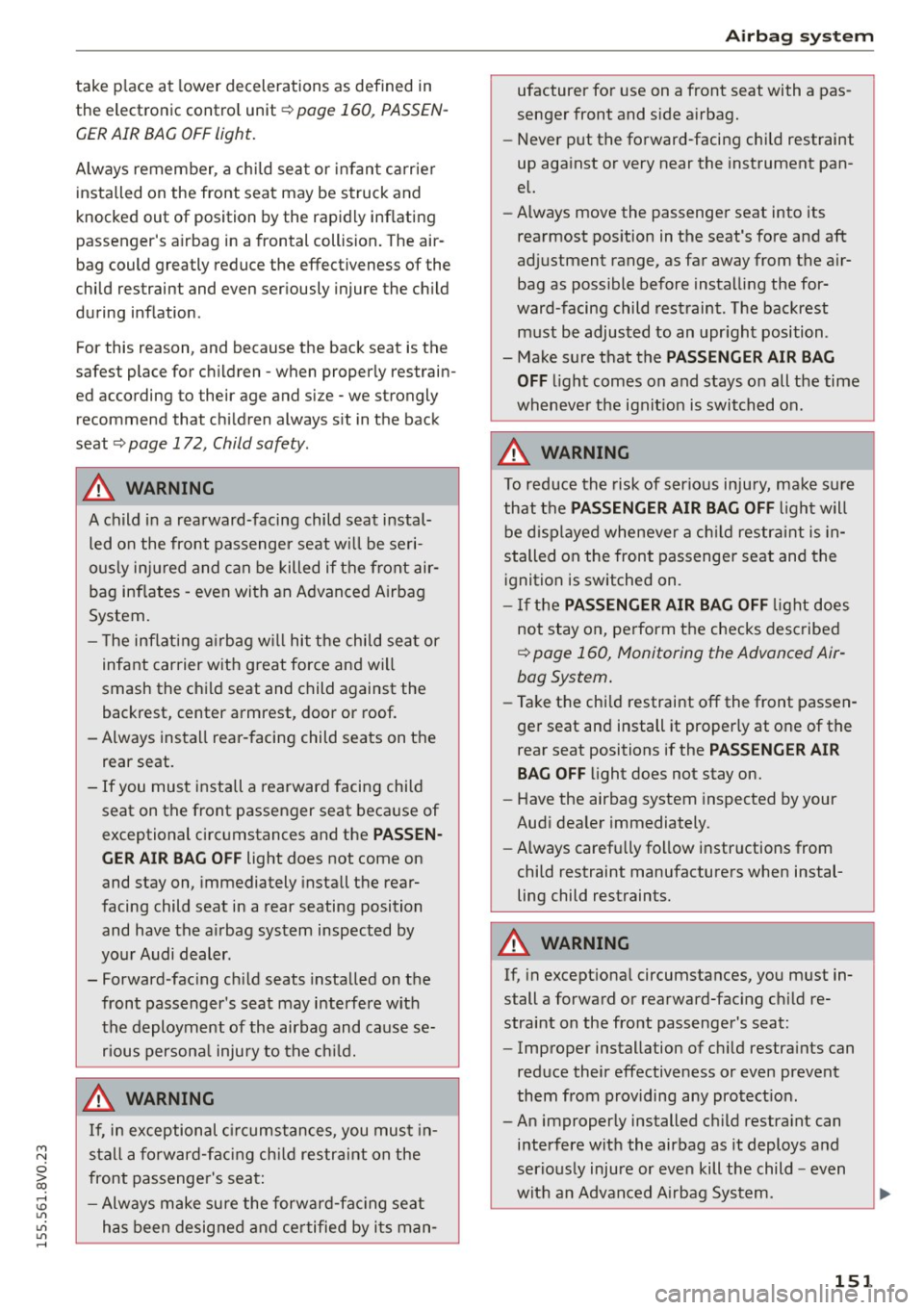
M N
0 > co ,...., \!) 1.1'1
1.1'1
1.1'1
,....,
take place at lowe r decelerations as defined in
the electronic contro l unit ¢
page 160, PASSEN
GER AIR BAG OFF light.
Always remember, a chi ld seat or infant carrie r
installed on the front seat may be struck and
knocked out of position by the rapidly inflating
passenger's a irbag in a frontal collision . The air
bag could greatly reduce the effectiveness of the
child restraint and even ser iously injure the ch ild
during inflation .
For this reason, and because the back seat is the
safest place for ch ildren -when properly restrain
ed according to their age and s ize -we strongly
recommend that ch ild ren always s it in the back
seat
¢ page 172, Child safety .
A WARNING
A child in a rearward-facing child seat instal
led on the front passenger seat w ill be seri
ously in jured and can be killed if the front air
bag inflates -even with an Advanced Airbag
System.
- T he inflating a irbag w ill hit the child seat or
infant carrier w ith great force and will
smash the child seat and child against the
backrest, center armrest, door or roof.
-
- Always install rear -facing child seats on the
rear seat.
- If you mus t install a rearward facing child
seat on the front passenger seat beca use of
exceptional circ umstances and the
PASSEN ·
GER AIR BAG OFF
light does not come on
and stay on, immediately install the rear
facing child seat in a rear seating position
and have the a irbag system inspected by
yo ur Audi dealer.
- Forward-fac ing ch ild seats installed on the
front passenger's seat may interfere with
the deployment of the airbag and cause se rious persona l injury to t he ch ild.
A WARNING
If, in exceptional c ircumstances, you mus t in
stall a forward-facing ch ild restraint on the
front passenger's seat :
- Always make sure the forward-fac ing seat
h as been designed and ce rtified by i ts man-
Airbag syste m
ufacturer for use on a front seat with a pas
senger front and s ide a irbag.
- Never put t he fo rward-facing child restraint
up aga inst or very near the instrument pan
el.
- Always move the passenge r seat into its
rearmost pos ition in the seat's fore and aft
ad justment range, as far away from the a ir
bag as possible before installing the for
ward-facing child restraint. The backrest
m ust be adjusted to an upr ight position .
- Make sure that the
PASSENGER AIR BAG
OFF
li ght comes on and stays on all the time
wheneve r the ignit ion is switched on.
A WARNING
= -To reduce the risk of serious inju ry, ma ke su re
that t he
PASSENGER AIR BAG OFF ligh t will
b e d isplayed whenever a ch ild restr aint is in
stalled on the front passenger seat and the
ignition is switched on.
- If the PASSENGER AIR BAG OFF light does
not stay on, pe rform the checks describe d
~ page 160, Monitoring the Advanced Air ·
bag System.
-Take the chi ld restraint off the front passen
ge r seat and install it properly at one of the
rea r seat positions if the
PASSENGER AIR
BAG OFF
light does not stay on.
- Have the airbag system inspected by your
Aud i dealer immediately.
- Always carefu lly follow instr uctions from
child restraint manufacturers when instal
ling child restraints.
A WARNING
If, in except ional circumstances, you m ust in
stall a forward or rearward-fac ing ch ild re
straint on the front passenger's seat:
- Improper installation of ch ild restra ints can
red uce their effectiveness or even prevent
them from providing any pro tect ion.
- An improperly installed ch ild restra int can
interfere with the airbag as it deploys and
serio usly injure or even kill the child -even
with an Advanced A irbag Sys tem.
~
151
Page 154 of 282
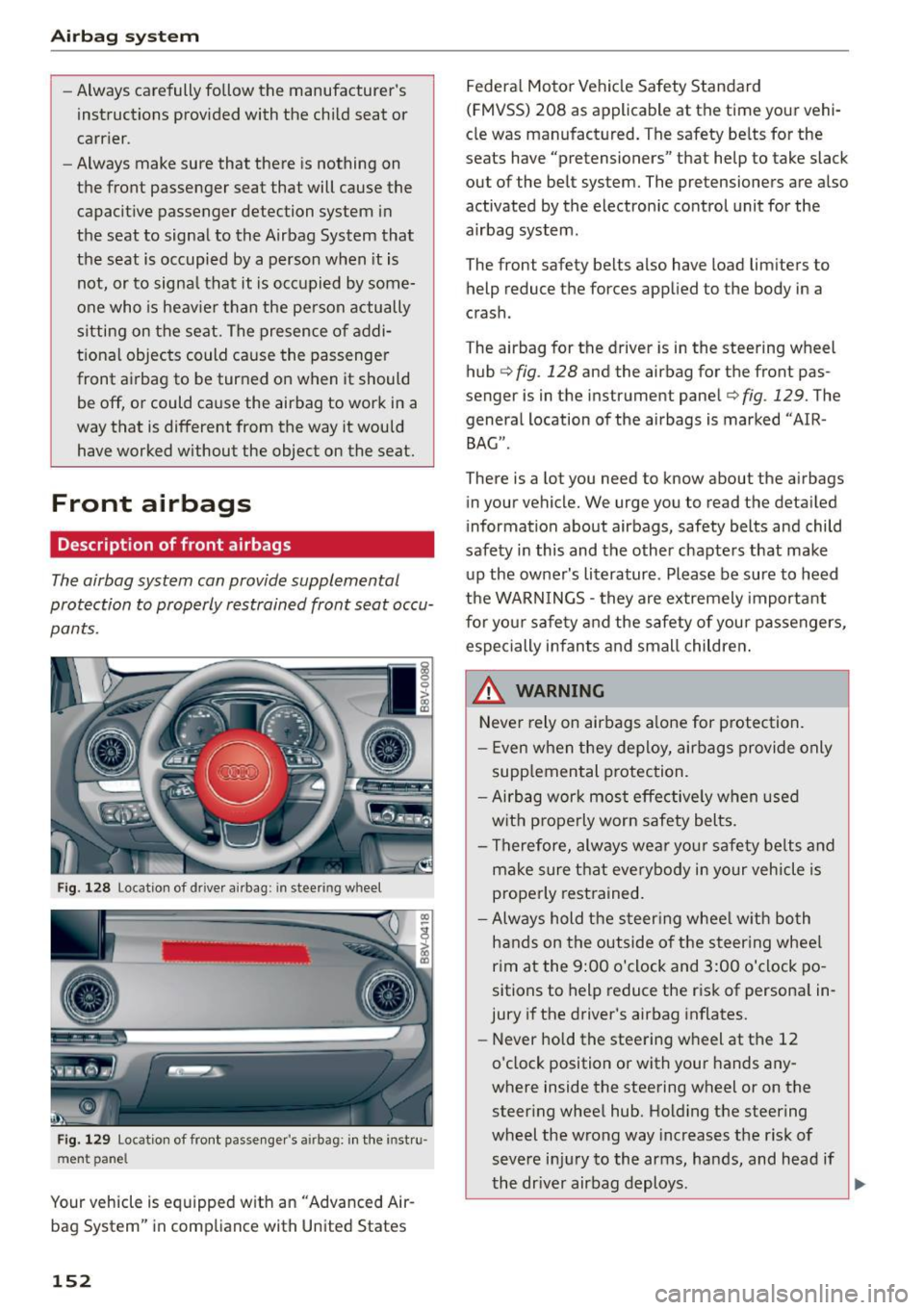
Airb ag syst em
-Always carefully follow the manufacturer's
instructions provided with the child seat or
carr ier.
- Always make sure that there is nothing on
the front passenger seat that will cause the
capacit ive passenger detection system in
the seat to signal to the Airbag System that
the seat is occupied by a person when it is
not, or to signa l that it is occupied by some
one who is heav ier than the person actually
sitting on the seat. The presence of addi
tional objects could cause the passenger
front a irbag to be turned on when it should
be off, or could cause the airbag to work in a
way that is different from the way it would have worked without the object on the seat.
Front airbags
Description of front airbags
The airbag system can provide supplemental
protection to properly restrained front seat occu
pants.
F ig. 128 Location of d river ai rbag: in steeri ng w heel
F ig. 129 Location of fro nt passenger's a irbag: in the i nstru
m ent pane l
Your vehicle is equipped w ith an "Advanced Air
bag System" in compliance with United States
152
Federa l Moto r Vehicle Safety Standard
(FMVSS) 208 as applicable at the time your vehi
cle was manufactured. The safety be lts for the
seats have "pretensioners" that help to take slack
out of the belt system. The pretensioners are also
activated by the electronic control unit for the
airbag system.
The front safety belts also have load lim iters to
help reduce the forces applied to the body in a
crash .
The airbag for the driver is in the steering wheel
hub ¢
fig. 128 and the airbag for the front pas
senger is in the instrument panel¢
fig. 129. The
genera l location of the airbags is marked ''AIR
BAG ".
There is a lot you need to know about the a irbags
in your vehicle. We urge you to read the detailed
information about airbags, safety belts and child
safety in this and the other chapte rs that make
up the owner's literature . Please be sure to heed
the WARN INGS - they are extremely important
for your safety and the safety of your passengers,
especially infants and small children .
A WARNING -
Never rely on airbags alone for protection.
- Even when they deploy, airbags provide only
supp lemental p rotection.
- Airbag wor k most effective ly when used
w it h properly worn safety belts.
- Therefore, alw ays wea r your safe ty belts and
ma ke sure that everybody in your vehicle is
properly rest rained.
- Always hold the s teer ing whee l w ith bo th
hands on the outside of the steer ing whee l
r im at the 9:00 o'clock and 3:00 o'clock po
sitions to help reduce the r isk of persona l in
jury if the driver's airbag in flates.
- Never hold the steering wheel at the 12
o'clock position or with your hands any
where inside the steering wheel or on the
steer ing whee l hub. Hold ing the steer ing
wheel the wrong way increases the risk of
severe in jury to the arms, hands , and head if
the dr iver airbag deploys .
ll>
Page 155 of 282
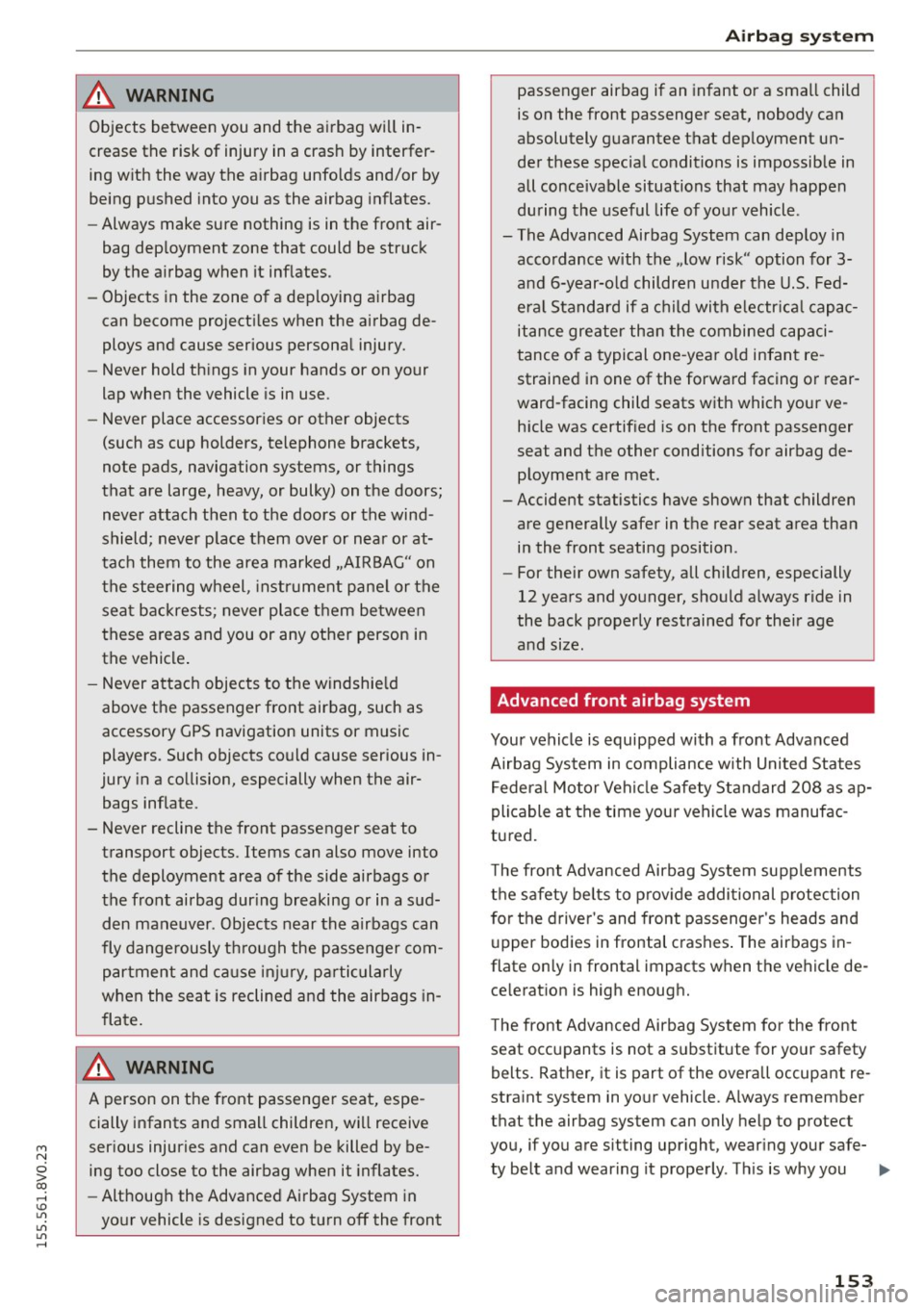
M N
0 > co ...... \!) 1.1'1
1.1'1
1.1'1
......
_& WARNING
Objects between you and the airbag will in
crease the risk of injury in a crash by interfer
ing with the way the airbag unfolds and/or by
being pushed into you as the airbag inflates.
- Always make sure nothing is in the front air-
bag deployment zone that could be struck
by the airbag when it inflates.
- Objects in the zone of a deploying airbag
can become projectiles when the airbag de
ploys and cause serious personal injury.
- Never hold things in your hands or on your
lap when the vehicle is in use.
- Never place accessories or other objects
(such as cup holders, telephone brackets,
note pads, navigation systems, or things
that are large, heavy, or bulky) on the doors; never attach then to the doors or the wind
shield; never place them over or near or at
tach them to the area marked ,,AIRBAG" on
the steering wheel, instrument panel or the
seat backrests; never place them between
these areas and you or any other person in
the vehicle.
- Never attach objects to the windshield
above the passenger front airbag, such as
accessory GPS navigation units or music
players. Such objects could cause serious in
jury in a collision, especially when the air
bags inflate.
- Never recline the front passenger seat to
transport objects. Items can also move into
the deployment area of the side airbags or
the front airbag during breaking or in a sud den maneuver. Objects near the airbags can
fly dangerously through the passenger com
partment and cause injury, particularly
when the seat is reclined and the airbags in
flate.
_& WARNING
A person on the front passenger seat, espe cially infants and small children, will receive
serious injuries and can even be killed by be
ing too close to the airbag when it inflates.
- Although the Advanced Airbag System in
your vehicle is designed to turn off the front
-
Airbag system
passenger airbag if an infant or a small child
is on the front passenger seat, nobody can
absolutely guarantee that deployment un
der these special conditions is impossible in
all conceivable situations that may happen
during the useful life of your vehicle.
- The Advanced Airbag System can deploy in
accordance with the ,,low risk" option for 3-
and 6-year-old children under the U.S. Fed
eral Standard if a child with electrical capac
itance greater than the combined capaci
tance of a typical one-year old infant re
strained in one of the forward facing or rear
ward-facing child seats with which your ve
hicle was certified is on the front passenger
seat and the other conditions for airbag de
ployment are met.
- Accident statistics have shown that children
are generally safer in the rear seat area than
in the front seating position .
- For their own safety, all children, especially
12 years and younger, should always ride in
the back properly restrained for their age
and size.
Advanced front airbag system
Your vehicle is equipped with a front Advanced
Airbag System in compliance with United States
Federal Motor Vehicle Safety Standard 208 asap
plicable at the time your vehicle was manufac
tured.
The front Advanced Airbag System supplements
the safety belts to provide additional protection
for the driver's and front passenger's heads and
upper bodies in frontal crashes. The airbags in
flate only in frontal impacts when the vehicle de
celeration is high enough.
The front Advanced Airbag System for the front
seat occupants is not a substitute for your safety
belts. Rather, it is part of the overall occupant re
straint system in your vehicle. Always remember
that the airbag system can only help to protect
you, if you are sitting upright, wearing your safe-
ty belt and wearing it properly . This is why you ..,.
153
Page 156 of 282
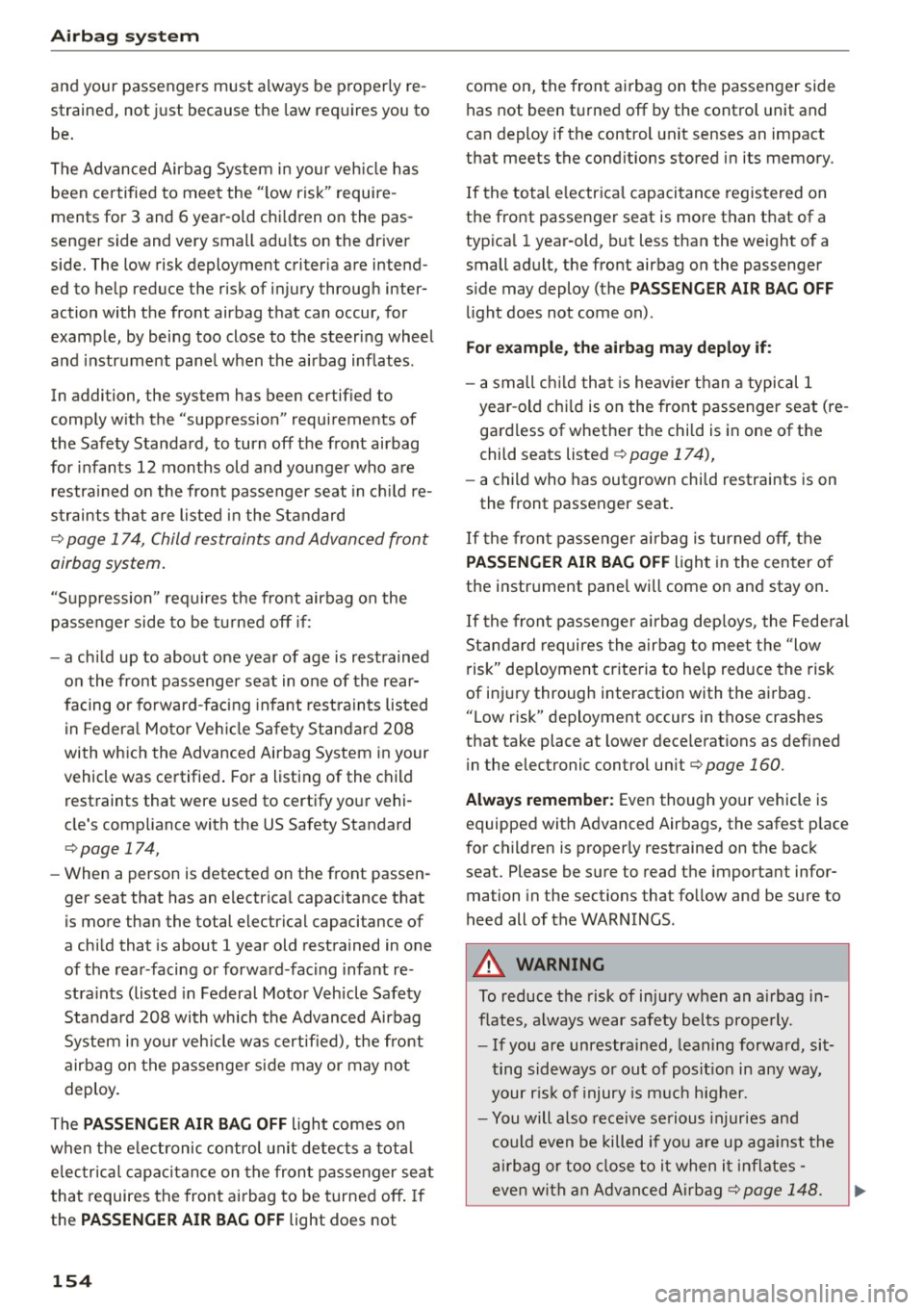
Airbag system
and your passengers must always be properly re
strained, not just because the law requires you to
be .
The Advanced Airbag System in your veh icle has
been certified to meet the " low risk" require
ments for 3 and 6 year-old chi ldren on the pas
senger side and very small adu lts on the driver
side. The low risk deployment criteria are intend
ed to help reduce the risk of injury through inter
action with the front airbag that can occur, for
example, by being too close to the steer ing wheel
and instrument panel when the airbag inflates.
In addition, the system has been certified to
comp ly with the "suppress ion" requirements of
the Safety Standard, to turn off the front airbag
for infants 12 months old and younger who are
restrained on the front passenger seat in child r e
straints that are listed in the Standard
¢ page 17 4, Child restraints and Advanced front
airbag system.
"Suppression" requires the front airbag on the
passenger side to be turned off if:
- a child up to about one year of age is rest rained
on the front passenger seat in one of the rear
facing or forward-facing infant rest raints listed
in Federal Motor Vehicle Safety Standard 208
with which the Advanced Airbag System in your
vehicle was certified . For a listing of the child
restraints that were used to certify your vehi
cle's comp liance with the US Safety Standard
¢ page 174,
-When a person is detected on the front passen
ger seat that has an electrica l capacitance that
is more than the total electrical capacitance of
a child that is about 1 year old restrained in one
of the rear-facing or forward-facing infant re
stra ints (listed in Federal Motor Veh icle Safety
Standard 208 with which the Advanced Airbag
System in your veh icle was certified), the front
airbag on the passenger side may or may not
deploy.
The
PASSENGER AIR BAG OFF light comes on
when the electronic control unit detects a total
elec trical capacitance on the front passenger seat
that requires the front airbag to be turned off. If
the
PASSENGER AIR BAG OFF light does not
154
come on, the front airbag on the passenger side
has not been turned off by the contro l unit and
can deploy if the control unit senses an impact
that meets the cond itions stored in its memory.
If the total electrica l capacitance registered on
the front passenger seat is more than t hat of a
typ ica l 1 year-old, but less than the we ight of a
small adult, the front airbag on the passenger
s ide may deploy (the
PASSENGER AIR BAG OFF
li ght does not come on).
For example, the airbag may deploy if:
-a small ch ild that is heavier than a typical 1
year -old chi ld is on the front passenger seat (re
gardless of whether the chi ld is in one of the
child seats listed
¢ page 17 4),
- a child who has outgrown chi ld restraints is on
the front passenger seat.
If the front passenger airbag is turned off, the
PASSENGER AIR BAG OFF light in the center of
the instrument panel will come on and stay on.
If the front passenger ai rbag deploys, the Federal
Standard requires the airbag to meet the "low
risk" deployment criteria to help reduce the risk
of inj ury through interaction with the airbag.
"Low risk" deployment occurs in those crashes
that take place at lower decelerations as defined
i n the electronic control un it
¢ page 160.
Always remember: Even though yo ur vehicle is
equipped with Advanced Airbags, the safest p lace
for children is properly restrained on the back
seat. Please be sure to read the important infor
mation in the sections that follow and be sure to
heed all of the WARNINGS.
A WARNING
To reduce the risk of injury when an airbag in
flates, always wear safety belts properly.
- If you are unrestrained, leaning forward, sit
ting sideways or out of position in any way,
your risk of injury is much higher.
- You will also receive serious injuries and
could even be killed if you are up against the
airbag or too close to it when it inflates -
even with an Advanced Airbag
¢page 148.
Page 157 of 282
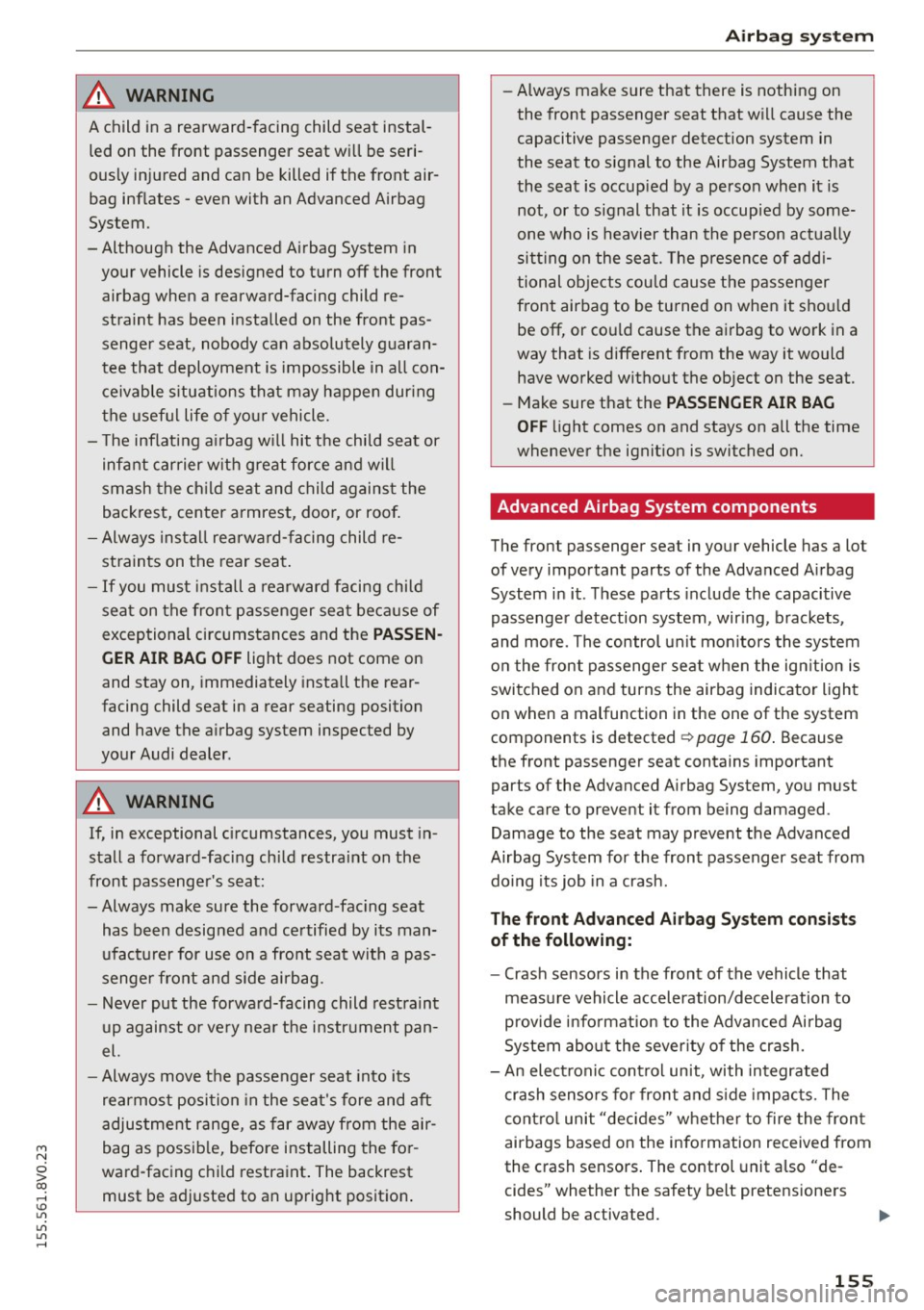
M N
0 > co ,...., \!) 1.1'1
1.1'1
1.1'1
,....,
A WARNING
A child in a rearward-facing child seat instal
led on the front passenger seat wi ll be seri
ously injured and can be killed if the front air
bag inflates -even with an Advanced Airbag
System.
-Although the Advanced Airbag System in
your vehicle is designed to turn off the front
airbag when a rearward-facing child re
straint has been installed on the front pas senger seat, nobody can absolutely guaran
tee that deployment is impossible in all con
c eivable s ituations that may happen dur ing
the useful life o f you r vehicle.
- The inflating a irbag w ill hit the child seat or
infant carrier w ith great force an d will
smash the ch ild seat and child agains t the
backrest, center armrest, doo r, or roo f.
- Alw ays install rearward- facing child re
straints on the rear seat .
- If you must i nst all a rearw ard facing child
sea t on the front passenger sea t beca use of
excep tional circ umstances and the
PASSEN
GER AIR BAG OFF light does not come on
and stay on, immediately install the rear
facing child seat in a rear seating position
and have the a irbag system inspected by
your Audi dealer.
A WARNING
If, in exceptional c ircumstances, you must in
stall a forward-facing ch ild restraint on the
front passenge r's seat:
-Always make sure the forward-fac ing seat
has be en designed and certified by its man
ufact urer for use on a fro nt seat wit h a pas
senger front and side airbag.
- Never put the forwa rd-facing child rest raint
up against or ve ry nea r the i nstr ument pan
el.
-Always move t he passenger seat into its
rearmost position in the seat 's fore and aft
adjus tment range, as far away from the air
bag as possib le, before installing the fo r
ward-facing c hild restraint . The backrest
must be adjusted to an up right position .
-
Airbag syste m
- Always make sure that there is nothing on
the front passenger seat that w ill cause the
capacitive passenger detection system in
the seat to signal to the Airbag System that
the seat is occup ied by a person when it is
not, or to signal that it is occupied by some
one who is heavier than the person actually
sitt ing on the se at. T he presen ce of add i
tion al ob jects could cause t he passenger
front airbag to be tu rned on when it shou ld
be off, or co uld cause the ai rbag to wo rk in a
way that is different from the way it would
have worked without the ob ject on the seat.
- Make sure that the
PASSENGER AIR BAG
OF F light comes on and stays on all the time
wheneve r the ignit ion is switched on.
Advanced Airbag System components
The front passenger seat in yo ur vehicle has a lot
of very impo rtant parts of the Advanced A irbag
System in it . T hese pa rts include the capacitive
passenge r detection system, wir ing, brackets,
and more. The con trol unit mon itors the syste m
o n the front passenge r se at when the ig nition is
swi tched on and turns the airbag indicator ligh t
on when a malfunction in the one of the system
components is detected
¢ page 160 . Because
the front passenger seat contains important
parts of the Advanced A irbag System, yo u m ust
take care to prevent it from being damaged.
Damage to the seat may prevent the Advanced
Airbag System for the front passenger seat from
doing its job in a crash.
The front Advanced Airbag System consi sts
of the following:
- Crash sensors in the front of the vehicle that
measure vehicle acceleration/deceleration to
p rov ide i nfo rmat ion to the Advanced Airbag
System abo ut the sever ity o f the cr ash.
- An elect ron ic cont ro l unit, with integrated
cr ash senso rs for front and s ide imp acts. The
cont ro l uni t "dec ides" whet her to fire the fron t
airbags based on the info rmation received from
the crash sensors . The control unit a lso "de
cides" whether the safety belt pretens ione rs
should be activated. ..,.
155
Page 158 of 282
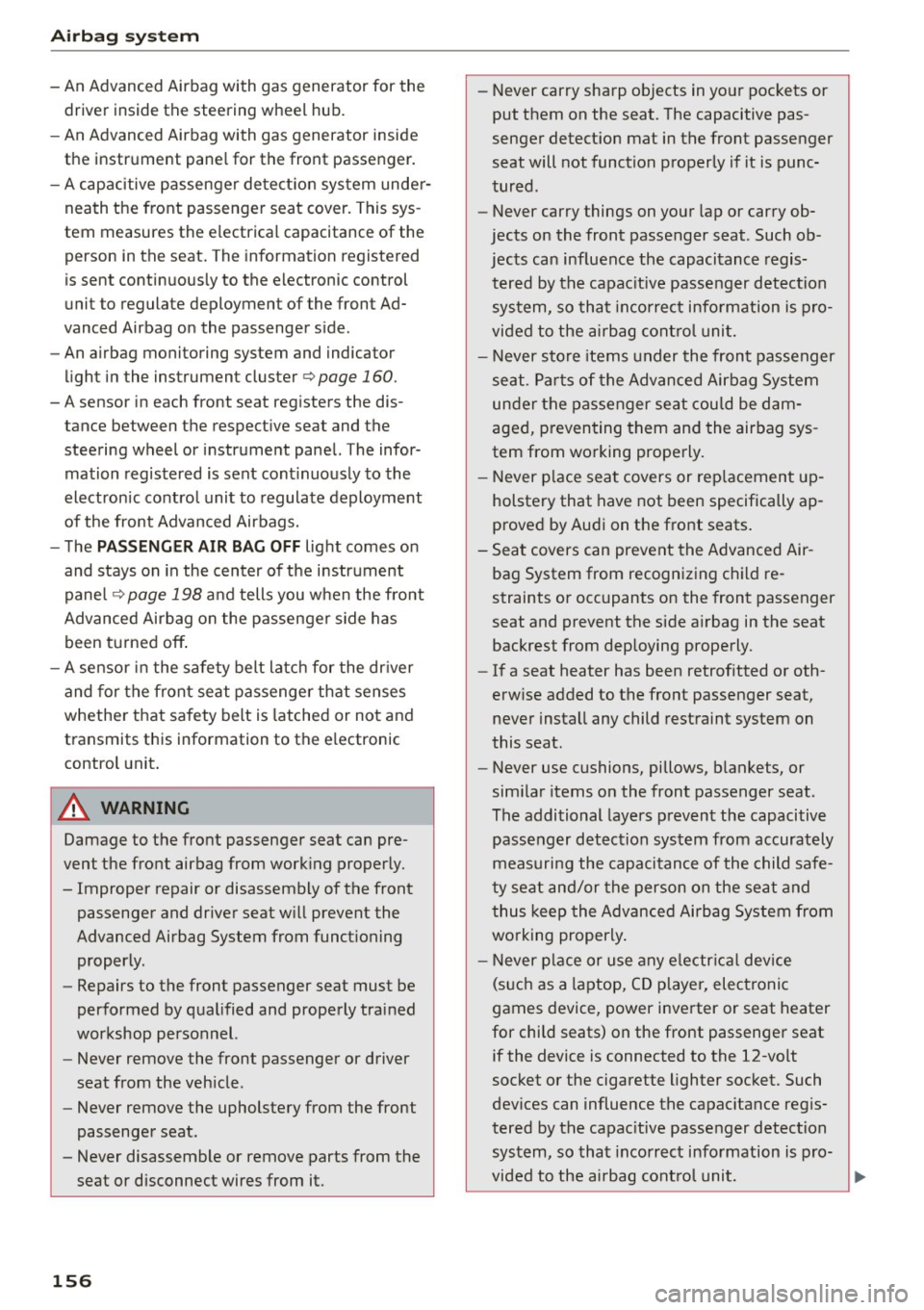
Airbag syste m
-An Advanced Airbag wi th gas generator for the
driver inside the steering wheel hub.
- An Advanced Airbag with gas generator inside
the instrument pane l for the front passenger.
- A capacitive passenger dete ct ion system under
neath the front passenge r seat cover. This sys
tem measures the e lectrical capacitance of the
person in the seat. The information registered
is sent continuously to the electronic control
unit to regulate deployment of the front Ad
vanced Airbag on the passenger s ide.
- An airbag monitoring system and indicator
light in the instrument cluster¢
page 160.
-A sensor in each front seat registers the dis
tance between the respect ive seat and the
steering wheel or instrument panel. The infor
mation registered is sent cont inuously to the
electronic control unit to regulate deployment
of the front Advanced Airbags.
- The
PASSENGER AIR BAG OFF light comes on
and stays on in the center of the instrument
pane l¢
page 198 a nd tells you when the front
Advanced Airbag on the passenger side has been t urned off .
- A sensor in the safety belt latch for the dr iver
and for the front seat passenger that senses
whether that safety belt is latched or not and
transmits this information to the e lectronic
control unit .
_&. WARNING
Damage to the front passenger seat can pre
vent the front airbag from work ing properly.
- Improper repair or disassembly of the front
passenger and driver seat w ill prevent the
Advanced Airbag System from funct ioning
properly.
- Repairs to the front passenger seat must be
performed by qualified and properly trained
workshop personnel.
- Never remove the front passenger or driver
seat from the veh icle.
- Never remove the upholstery from the front
passenger seat.
- Never disassemble or remove parts from the
seat or disconnect wires from it.
156
- Never carry sharp objects in yo ur poc kets or
put them on the seat. The capacitive pas
senger detection mat in the front passenger
seat will not function properly if it is punc
tured.
- Never carry things on you r lap or carry ob
jects on the front passenger seat. Such ob
jects can influence the capacitance regis
tered by the capac itive passenger detection
sy stem, so that in correct info rmation is pro
vided to the airbag cont rol uni t.
- Never store items under the front passenger
se at. P arts of the Advanced Airbag System
under the passenger seat could be dam
aged, p reventing t hem and the airbag sys
tem from wo rking properly.
- Never p lace sea t covers or rep lacement up
holstery that have not been specifically ap
proved by Audi on the front seats .
- Seat covers can prevent the Advanced Air
bag System from recognizing c hild re
straints or occupants on the front passenger
seat and prevent the side a irbag in the seat
backrest from deploying properly.
- If a seat heater has been retrofitted or oth
erw ise added to the front passenger seat,
never install any child restraint system on
this seat.
- Never use cushions, pillows, b lankets, or
sim ila r items on the front passenger seat .
The additional layers prevent the capacitive
passenger detection system from accurately
measuring the capacitance of the child safe
ty seat and/or the person on the seat and
thus keep the Adv ance d Airbag System from
wo rking properly .
- Never p lace or u se any e lectr ic al device
(s uc h a s a laptop, CD player, elec tronic
games device, power inve rter or seat heater
for child seats) on the front passenger seat if the device is connected to the 12 -volt
socket or the cigarette lighter soc ket. Such
dev ices can influence the capac itance regis
tered by the capac itive passe nger detection
system, so that incorrect info rmation is pro-
vided to the ai rbag cont rol unit.
~
Page 159 of 282
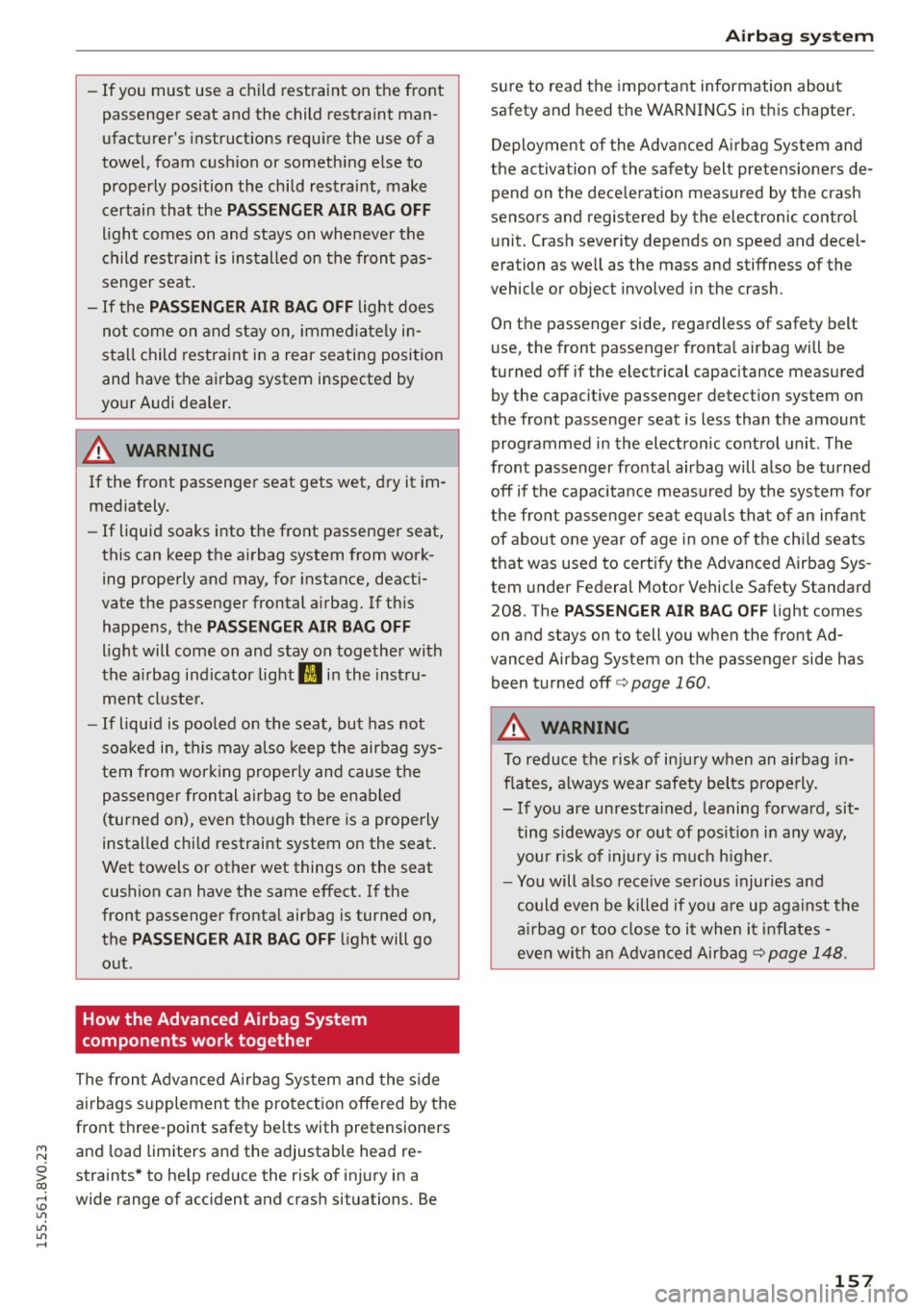
M N
0 > co ,...., \!) 1.1'1
1.1'1
1.1'1
,....,
-If you must use a child restraint on the front
passenger seat and the child restraint man
ufacturer's instructions requ ire the use of a
towel, foam cushion or someth ing else to
properly position the child restraint, make
certain that the
P A SSENG ER AIR BAG OFF
light comes on and stays on whenever the
child restrain t is ins talled on the fron t pas
senger seat.
- If the
PASSENGER AIR BAG OFF light does
not come on and stay on, immed iately in
sta ll child restra int in a rear seating position
and have the airbag system inspected by
yo ur Audi dealer .
&_ WARNING
If the front passenger seat gets wet, dry it im
mediately.
-If liquid soaks into the front passenger seat,
this can keep the airbag system from work ing properly and may, for instance, deacti
vate the passenger frontal a irbag. If th is
happens, the
PASSENGER AIR BAG OFF
light will come on and stay on together with
the a irbag indicator light
II in the inst ru
me nt cluster.
- If liquid is poo led on the seat, but has not
soa ked in, this may a lso keep the airbag sys
tem from wor king proper ly and cause the
passenger fron tal ai rbag to be ena bled
(turned on), even tho ugh there is a properly
installed chi ld restraint system on the seat .
Wet towels or other wet things on the seat c u shion can have the same effect. If the
front passenger fronta l airbag is turned on,
the
PASSENGER AIR BAG OFF light will go
o ut.
How the Advanced Airbag System
components work together
The fron t Advanced A irbag Sys tem and the s ide
ai rbags supplement the pro tect ion offered by the
front three-point safety be lts with pretensioners
and load limiters and the adjustable head re
straints* to he lp red uce the risk of in jury in a
wide range of acc ident and cras h situations. Be
Airbag syste m
su re to read the important information about
safety and heed the WARNINGS in this chapter .
Deployment o f the Adv anced A irbag System and
the ac tivation of the sa fety belt pretensione rs de
pend on the dece lerat ion meas ured by the crash
sensors and registered by the e lectronic control
u nit . Cras h seve rity depends on speed and decel
eration as we ll as the mass and stiffness of the
vehicle or object involved in the crash .
On t he passenger side, regardless of safety belt
u se, the front passenger fronta l airbag will be
turned off if the electrical capacitance meas ured
by the capacitive passenger detection system on
the front passenger seat is less than the amount programmed in the electronic control unit . T he
front passeng er fronta l airbag will a lso be turned
off if the capac itance meas ured by t he system for
the front passenger sea t eq uals tha t of an inf ant
of about one year o f age in one of t he chi ld seats
that was used to certify the Advanced Airbag Sys
tem under Federal Motor Vehicle Safety Standard
208. The
PASSENGER AIR BAG OFF light comes
on and stays on to tell you when the front Ad
vanced Airbag System on the passenger side has been turned
off c::>page 160 .
&_ WARNING
-To reduce the risk of in jury w hen an a irbag in-
flates, always wear safety belts prope rly .
- If you are unrestra ined, leaning forward, sit
ting sideways or out of posit ion i n any way,
your r is k of injury is m uch higher.
- You will a lso receive se rious injur ies an d
could even be killed if you a re up aga inst th e
ai rbag or too close to i t when i t in flates -
even with an A dvan ced Airb ag
<=:> page 14 8.
157
Page 160 of 282
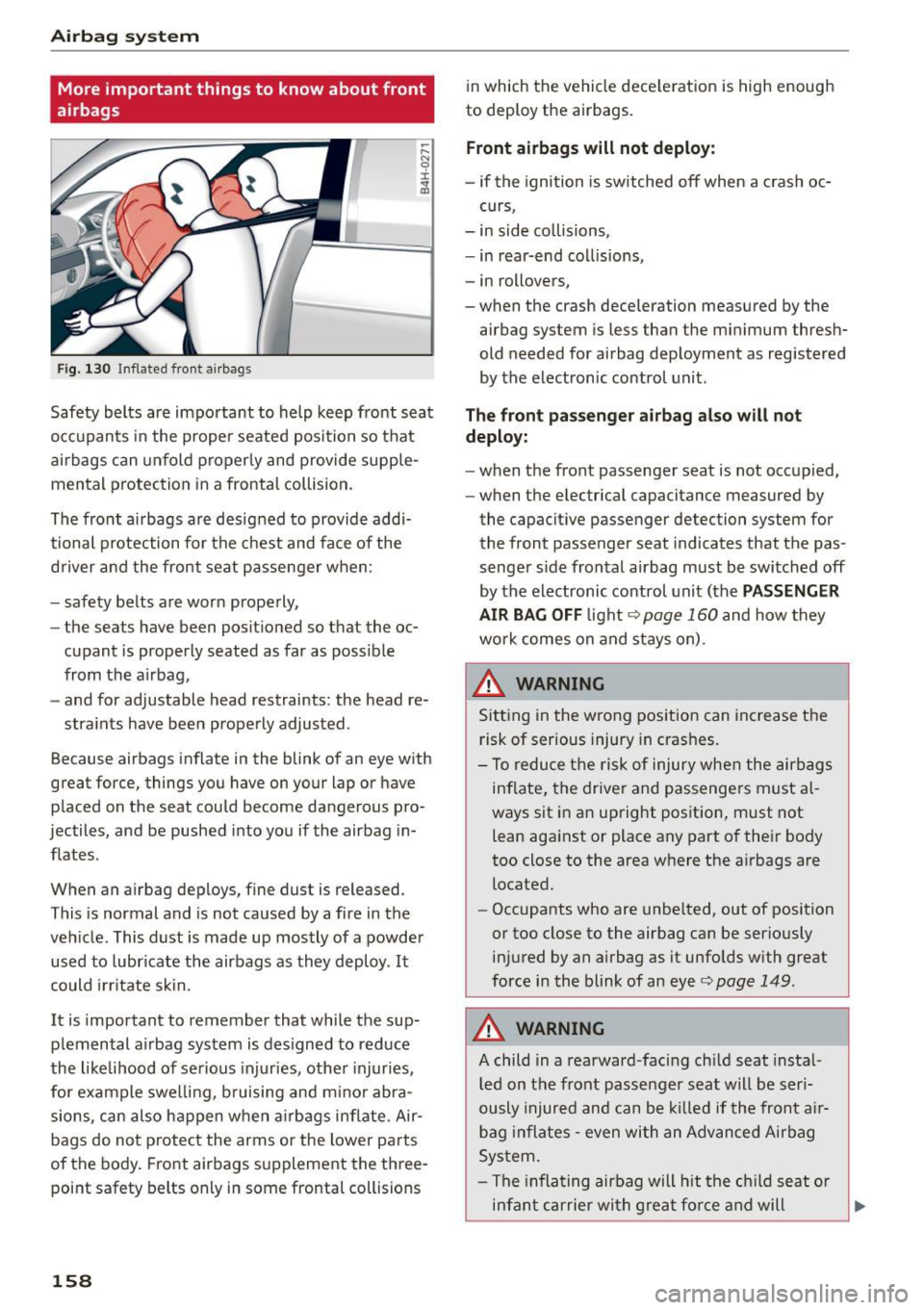
Airb ag syst em
More important things to know about front
airbags
Fig. 130 Inflated front airbags
Safety belts are important to help keep front seat
occupants in the proper seated position so that
ai rbags can unfold properly and provide supple
mental protection in a frontal collision.
The front airbags are designed to provide addi
tional protection for the chest and face of the
d river and the front seat passenger when:
- safety belts are worn properly,
- the seats have been posit ioned so that the oc-
cupant is properly seated as far as poss ible
from the a irbag,
- and for adjustable head restraints: the head re-
straints have been properly adjusted .
Because airbags inflate in the blink of an eye with
great force, things you have on your lap or have
placed on the seat could become dangerous pro
jectiles, and be pushed into you if the airbag in
flates.
When an airbag deploys, fine dust is released.
This is normal and is not caused by a fire in the
veh icle. This dust is made up mostly of a powder
used to lubricate the airbags as they deploy .
It
could irritate sk in .
It is important to remember that while the sup
plemental a irbag system is designed to reduce
the likelihood of serious injuries, other injuries,
for example swell ing, bruising and m inor abra
sions, can also happen when a irbags inflate. Air
bags do not protect the arms or the lower parts
of the body. Front airbags supplement the three point safety belts only in some frontal collisions
158
in which the vehicle dece le ration is high enough
to deploy the airbags.
Front airbags will not depl oy:
- if the ignition is sw itched off when a c rash oc-
curs ,
- in side co llisions,
- in rear-end col lisions,
- in rollovers,
- when the crash deceleration measured by the
airbag system is less than the minimum thresh
old needed for airbag deployment as registered
by the electronic control unit.
The front pa ssenger a ir b ag als o will n ot
deploy:
- when the front passenger seat is not occupied,
- when the e lectrical capacitance measured by
the capacit ive passenger detection system for
the front passenger seat indicates that the pas
senger s ide frontal airbag must be switched off
by the electronic control unit (the
PASSENGER
A IR BAG OFF
light ¢ page 160 and how they
work comes on and stays on).
.&, WARNING
Sitt ing in the wrong position can increase the
risk of serious injury in cras hes.
- To reduce the risk of injury when the airbags
inflate, the driver and passenge rs must al
ways sit in an upright position, must not lean aga inst or place any part of thei r body
too close to the area w here the airbags are
located.
- Occupants who are unbelted, out of position
or too close to the airbag can be seriously
injured by an airbag as it unfolds with great
force in the blink of an eye
~ page 149 .
A WARNING
A child in a rearward-facing ch ild seat insta l
led on t he front passenger seat w ill be ser i
ously injured and can be k illed if the front a ir
bag inflates -even with an Advanced Airbag
Sys tem.
- The infla ting air bag will hit the ch ild seat o r
infant carrier wi th grea t fo rce and will